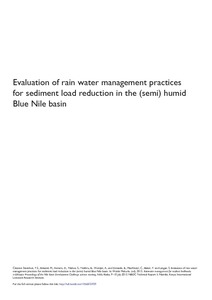Resource information
With the construction of the new Renaissance Dam at the Ethiopian Sudan border, reducing sediment load in the Blue Nile is becoming increasingly important. Past attempts of decreasing sediment concentrations have been only partially successful. In this paper, we will examine the temporal distribution of sediment generation within small watersheds and systematically compare this with the observed sediment concentration at various watershed scales using the Parameter Efficient Distributed (PED) model. The model is based on the concept that runoff and erosion are generated mainly from areas that become saturated during the rain storm. These runoff source areas consist of shallow soils over a dense hardpan or areas where the water table is close to surface. Saturated areas are also prone to gullying. Simulation of watershed evaluations indicate that most erosion occurs from degraded areas, from temporarily saturated agricultural land and from gullies in the saturated bottomlands near the river. In addition, we found that the annual runoff and sediment concentrations increased significantly in the Blue Nile basin at the border with Sudan. The model results would indicate that rehabilitating the degraded and bare areas by planting permanent vegetation and preventing further incision by gullies would be extremely effective in decreasing the sediment concentrations. Reduced tillage would likely result in less sediment transport but would increase use of pesticides and the cattle cannot graze freely anymore. Tentatively, we conclude that decreasing upland erosion might decrease sediment concentration downstream, since there is relatively little sediment storage in the main rivers of the Blue Nile basin.



